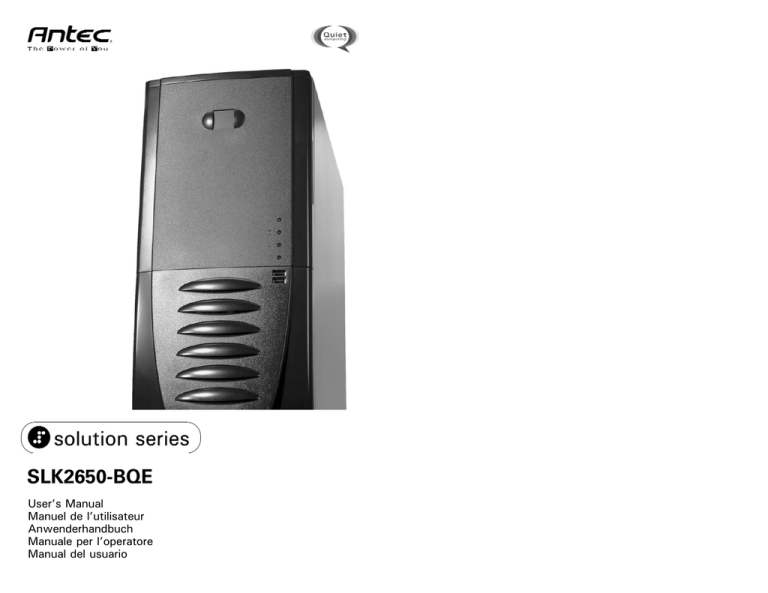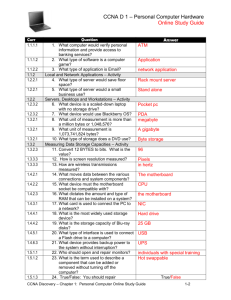SLK2650-BQE
advertisement

SLK2650-BQE User’s Manual Manuel de l’utilisateur Anwenderhandbuch Manuale per l’operatore Manual del usuario At Antec, we continually refine and improve our products to ensure the highest quality. So it's possible that your new case may differ slightly from the descriptions in this manual. This isn't a problem; it's simply an improvement. As of the date of publication, all features, descriptions, and illustrations in this manual are correct. Installing the Motherboard This manual does not cover CPU, RAM, or expansion card installation. Please consult your motherboard manual for specific mounting instructions and troubleshooting. 1. Disclaimer This manual is intended only as a guide for Antec's Computer Enclosures. For more comprehensive instructions on installing your motherboard and peripherals, please refer to the user's manuals which come with your components and drives. 2. 3. SLK2650-BQE - Quiet Black Mid Tower Case Your new case features a super-quiet 350 Watt SmartPower power supply, with a main power switch. Make sure you turn the switch to the ON ( I ) position before you boot up your computer for the first time. Normally, you won't need to switch to the OFF (O) position, since the power supply includes a soft on/off feature. This lets you turn your computer on and off by using the soft switch on your computer case. If your computer crashes and you can't shut it down using the soft switch, you can switch the main power to the OFF (O) position. [Applies only to models designed for sale in the European Union: Solution Series Power Supply models designed for the EU include Power Factor Correction (PFC) circuitry in accord with European standard regulation code EN61000-3-2. By altering the input current wave shape, PFC improves the power factor of the power supply. This results in increased energy efficiency, reduced heat loss, prolonged life for power distribution and consumption equipment, and improved output voltage stability.] Setting Up 1. Place the case upright on a flat, stable surface. The power supply fan should be at the back, facing you. Note (not applicable to models designed for the European Union): Before installation, check the red voltage switch setting on the power supply. It should match your local voltage (115V for North America, Japan, etc. and 230V for Europe and many other countries). If it doesn't match, please change the setting. If you don't, you could damage your equipment and void your warranty. 2. Remove the screws from the right side panel. Grip the panel at the fingergrip indent and slide it towards you to open the case. 3. Inside the case you should see the power supply, some wiring with marked connectors (USB, PWR etc.), an installed I/O panel and a power cord. You will also find an expansion slot protective cover mounted above the expansion slots. 4. In order to install expansion cards, remove the protective cover by pressing the tab on the cover. Note: Inside this cover, you'll find a compartment marked "hardware." Inside this compartment, you can store hardware or small tools (screws, brass standoffs, plastic stands, etc.) 1 4. 5. 6. 7. Lay the case down, with the open side facing up. The drive cages and power supply should be visible. Make sure you have the correct I/O panel for your motherboard. If the panel provided with the case isn't suitable, please contact your mother board manufacturer for the correct I/O panel. Line up your motherboard with the standoff holes, and remember which holes are lined up. Not all motherboards will match with all of the provided holes; this is normal, and won't affect functionality. (In other words, there will likely be extra holes.) Remove your motherboard by lifting it up. Screw the brass standoffs into the threaded holes that line up with your motherboard. Do not overtighten the standoffs. Some standoffs may be pre-installed for your convenience. Place your motherboard on the brass standoffs. Screw in your motherboard to the standoffs with the provided Phillips-head screws. Your motherboard is now installed. Connecting the Power and LED The Antec Solution Series SmartPower power supply is an ATX12V form factor power supply with a single 20-pin Main Power Connector, a 6-pin AUX Power Connector, and a 4-pin +12V Power Connector for the motherboard. It also includes 2 SATA connectors, five to seven 4-pin Peripheral Power Connectors and one to two 4-pin Floppy Drive Power Connectors for your drives. It is backwards compatible to previous ATX form factor power supplies. If your motherboard does not support the AUX Power Connector or the +12V Power Connector, you can still use this power supply. The power supply is also equipped with a 3-pin fan signal connector. Connect it to one of the fan connectors on your motherboard. You may monitor the speed of the rear power supply fan through your motherboard BIOS or through the monitoring software that's supplied with your motherboard. Note: At low temperatures, the fan may run as slow as 1200 RPM. At these speeds, some motherboards may not properly detect the fan speed and may generate false warnings of fan failure. To ensure proper monitoring of the fan, please check your motherboard manual. 1. 2. 3. 4. 5. Connect the 20-pin ATX power connector (and AUX or +12V connectors if appropriate) to your motherboard. Connect the Reset switch (labeled RESET SW) to your motherboard at the RST connector. Make sure the label always faces the front of the case. Connect the Power Switch (labeled POWER SW) to the PWR connector on your motherboard. You'll find the Speaker connector (labeled SPEAKER) behind the PWR connector. The Power LED, Hard Drive LED, LED I & LED II connectors all share a single ribbon cable. Attach the Power LED (labeled POWER) and HDD LED 2 connectors to the appropriate headers on your motherboard. You can use the LED I and LED II connectors as you see fit; as SCSI LED, Message LED, etc. or any other function supported by your motherboard, expansion cards, and peripherals. Connecting the USB Ports You'll find two 5-pin internal USB connectors (on separate cable sets) attached to the front USB connectors. Note: If you want to use both front USB connectors and the 8-in-1 card reader, your motherboard must have at least 3 internal USB headers. Here's how to connect the internal USB connector to your motherboard headers: 1. 2. Check the USB pin layout in your motherboard user manual and make sure it follows this standard pin out: Pin 1: USB Power - may also be labeled +5V Pin 2: Negative Signal - may also be labeled P-, D-, USB0-, etc. Pin 3: Positive Signal - may also be labeled P+, D+, USB0+, etc. Pin 4: Ground Pin 5: Ground (sometimes this pin is missing) Note: Your motherboard's USB pin layout may differ from this common standard. If you're unsure of your motherboard's layout, please contact technical support at your motherboard's manufacturer. Connect the 5-pin USB connector so that the red wire is on Pin 1 (Power, or +5V). The second header may be reversed (Power pin at the opposite end of the row) so be careful when you plug in both connectors. 1 Motherboard Pin Layout 2 Pin Signal names 9 10 Pin Signal names 1 USB Power 1 2 USB Power 2 3 Negative Signal 1 4 Negative Signal 2 5 Positive Signal 1 6 Positive Signal 2 7 Ground 1 8 Ground 2 9 Key (No Connection) 10 Empty Pin Installing 3.5" Devices There is a 3.5" drive cage inside the case. It can hold 2 external 3.5" drives and 2 internal drives. 1. 2. 3. 4. 5. Release the cage by pulling the quick release lever towards the rear of the case. Slide the cage out and put it on a flat, level surface. Mount your floppy drives or other external devices in the top two drive bays. Mount your hard drive or other internal 3.5" devices into the lower drive bays with the special screws provided. Don't over-tighten. Over-tightening the screws will harm the vibration and noise reducing ability of the rubber grommets. Slide the drive cage back into the case and lock it. For each floppy drive you've installed, find a small 4-pin connector on the power supply and connect it to the male 4-pin connector on the floppy drive. 3 6. For each hard drive or other internal 3.5" device you've installed, find a large 4-pin peripheral connector on the power supply and connect it to the male 4-pin connector on the 3.5" device. Installing 5.25" Devices 1. You'll find four metal plates covering the front openings of the 5.25" drive bays. Each bay includes a screwless drive rail attached to the front of it. For each drive bay you wish to use, carefully twist the metal plate back and forth until it breaks off. Note: Be careful of the newly exposed metal where the grills were attached, as these areas are likely to be sharp. Don't break off the plates covering the drive bays that you're not currently using. 2. Remove the drive rail from the metal plate by gently lifting the release tab (left end) with one finger and sliding the drive rail to the left. Attach the drive rail to the right side of the 5.25" device by carefully aligning the drive rail as illustrated in Figure 1 and pressing along the spring wire from back to front to seat it as in Figure 2. Make sure the release tab is facing towards the front plate. 3. On the drive cage, find the black Locking Slider. Open this slider by squeezing it and sliding it towards the front of the case. 4. Slide the device into the drive bay until you hear a click. 5. Lock the drive into position by sliding the Locking Slider towards the rear of the case. 6. Connect a large 4-pin peripheral connector from the power supply to the male 4-pin connector on each device. 7. To install more drives, simply repeat the same procedure. Attaching the screwless Drive Rails Figure 2 Figure 1 Data Cable Connection After you have connected the devices to the power supply, you need to connect the data cables between the devices and the motherboard. For best data transfer and cooling performance Antec recommends using a premium rounded data cable like Antec Cobra Cables. Useful tip: The cables included with your devices should have a red strip on side indicating pin number 1. If you use these cables make sure that the red strip is on pin 1, usually toward the power connector. Installing the Fan We've included one low-speed 120mm exhaust fan with this case. This (rear) fan is mounted with a vibration-absorbing NoiseKiller™ kit, which will allow your computer to run extremely quietly. In the front of the case, you'll find a mount for an optional 80mm intake fan. If you decide to add an intake fan, we 4 recommend that you also install a NoiseKiller™ 80 kit. The rear fan is installed so that the air blows out of the case. Find a large 4-pin peripheral connector on the power supply and connect it to the male 4-pin connector on the fan. The front fan (optional) should be installed so that the air is blowing into the case from the front. To install it: 1. 2. 3. 3. Release the fan cage by squeezing the tabs. Put the fan in the cage and push it into place until it snaps tight. Snap the fan cage back into place. Connect a large 4-pin peripheral connector from the power supply to the male 4-pin connector on the front fan. Advanced Thermal Chassis Air Guide Your new case includes an advanced thermal chassis air guide, which provides cooling air directly to the CPU.The air guide consists of three parts: an upper duct, flange, and lower duct. If you prefer, you can adjust the distance between the lower duct and your CPU, for maximum cooling efficiency. Figure 3 Figure 4 You could also install an 80mm intake fan between the air guide and the case's side panel. This will further improve your system's cooling airflow. To install the optional fan: 1. 2. 3. 4. Remove Chassis Air Guide from the side panel Attach the fan to the side panel (see Figure 3.) Using the fan screws, lock the flange of the air guide to the fan (see Figure 4.) Connect a large 4-pin peripheral connector from the power supply to the male 4-pin connector on the fan. Antec Quality 3-Year parts and labor warranty (AQ3) See details at: http://www.antec-inc.com/warranty.html 5 6




